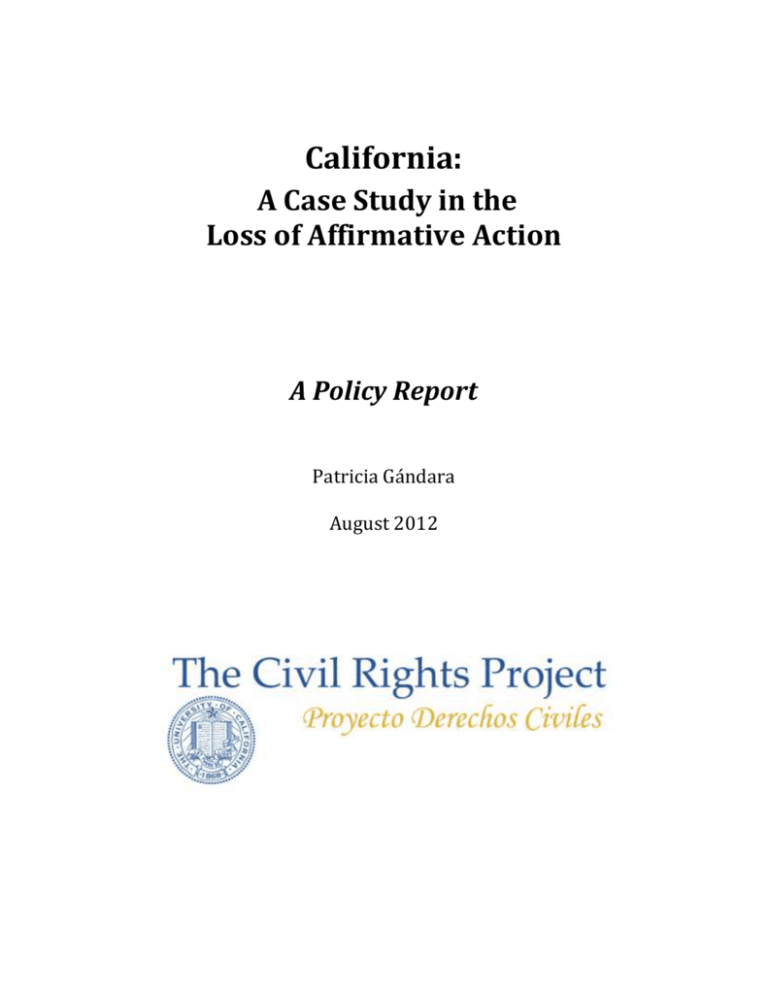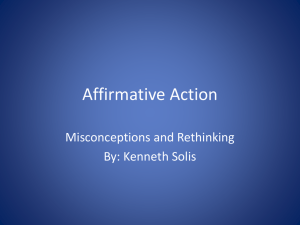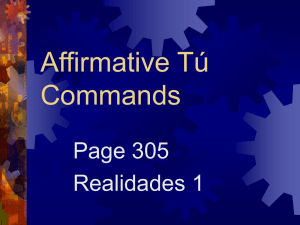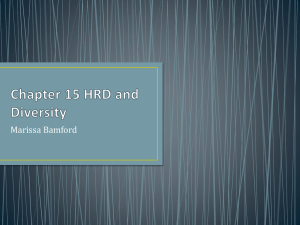California: A Case Study in the Loss of Affirmative Action
advertisement

California: A Case Study in the Loss of Affirmative Action A Policy Report Patricia Gándara August 2012 California: A Case Study in the Loss of Affirmative Action A Policy Report Patricia Gándara Executive Summary This paper briefly reviews the various efforts undertaken by the University of California to maintain diversity in the institution, and especially at its highly competitive flagship campuses, UCLA and Berkeley, in the face of the loss of affirmative action during the mid-1990s. It demonstrates the continuing decline in representation of underrepresented minorities (URMs) in spite of these efforts, even as URMs have become the majority of all students in the state. Although applications to the flagship campuses have doubled since 1995, and all groups have seen reductions in the percent of applicants offered admission, African American and Latino admittees have been reduced by 70 to 75 percent at UCLA and UC Berkeley, compared to just 35 and 40 percent for Asian and white applicants. This disproportionate decline reflects the inequalities in the California educational system that fails to prepare African American, Native American and Latino students for highly competitive selection processes irrespective of their intellectual ability or likelihood of succeeding in their studies. The consequences of continuing down the same path will likely result in the solidification of educational inequality and economic dislocations for the state. California: A Case Study in the Loss of Affirmative Action Ciivil Rights Project/Proyecto Derechos Civiles, August 2012 2 California: A Case Study in the Loss of Affirmative Action A Policy Report Patricia Gándara To understand what the likely outcomes of a loss of affirmative action nationally would be, one only needs to look to the state of California. The University of California was established with the mission to serve all of its residents equally in an effort to strengthen the economic and social well being of the state. The Organic Act, which established the University of California in 1868 stated: “. . . . it shall be the duty of the Regents, according to population, to so apportion the representation of students, when necessary, that all portions of the State shall enjoy equal privilege therein.” 1 Notwithstanding the initial commitment to educate “all portions” of the state’s youth, underrepresented minorities (URMs) have never achieved equal representation in the UC and their representation has declined since the mid-1990s just as their share of the state’s population has burgeoned. In 1995, the Regents of the University of California passed a special resolution, SP-1, which eliminated the use of affirmative action within the University. This was followed in 1996 by the passage of a statewide initiative— Proposition 209, which was promoted by the same authors of SP-1 and titled “the California Civil Rights Initiative,” with the goal of abolishing affirmative action throughout the state in both employment and university admissions. The first freshman class was not admitted under this policy until the fall of 1998, as the entire apparatus of admissions within the University had to be changed and potential applicants had to be noticed of the changes with sufficient time. Thus, California has now had almost a decade and a half of experience attempting to diversify its higher education system and maintain its national standing without the benefit of affirmative action in admissions. In 1995,2 under affirmative action, about 37 percent of all high school graduates in the state were Latino or African American, but barely 20 percent of the 1 California Assembly Bill 583. An Act introduced by Mr. Dwinelle, March 5, 1868 to Create and Organize the University of California. http://bancroft.berkeley.edu/CalHistory/charter.html 2 Although the removal of race-conscious policies for undergraduate applicants to the University of California did not take effect until the class entering in fall 1998, public discussion of, and attention to, the issue of affirmative action affected UC applications immediately. For the classes entering in Fall 1996 and Fall 1997, total applications rose (from 51,336 in 1995 to 56,401 in 1997), while those from underrepresented students fell (from 10,490 in 1995 to 9,858 in 1997), meaning that, as a proportion of the total, California: A Case Study in the Loss of Affirmative Action Ciivil Rights Project/Proyecto Derechos Civiles, August 2012 3 entering freshman class at the University of California came from these groups. Thus, there was already a significant gap in representation by minority students. Although the policy had not yet been implemented, the decline in representation of black and Latino students immediately after the 1995 resolution was precipitous. This was attributed in large part to a perception on the part of minority students that they were no longer welcome at UC.3 In the University system as a whole, there was a 22% decline in enrollments of African American students between 1995 and 1998 and a decline of 15% for Chicano/Latinos4 for the same period.5 The greatest impact however was felt at the flagship institutions of the University of California. For example, between 1997 and 1998, when the policy went into effect, freshman enrollments of African Americans declined by 52%, while Chicano/Latino enrollees declined by 43% at UC Berkeley. Similarly, at UCLA, black enrollments dropped by 32% while Chicano/Latino enrollments declined by 54% in the same period.6 Although there has been a modest recovery since that time, neither campus has regained the diversity it had in 1995, and admissions and enrollments for Blacks and Latinos continue to decline annually at both campuses. underrepresented applicants fell from 21.1 to 18.1 percent in two years (Office of the President of the University of California, Undergraduate Access to the University of California After the Elimination of Race-Conscious Policies, March 2003, page 17.) Therefore, we use 1995 as the baseline year to determine the effects of these two initiatives. 3 An internal study was commissioned by the Office of the President and conducted by the RAND Corporation in 1996, which surveyed eligible minority students who were not seeking admission to UC to determine why they had not chosen UC. The answer that came back was that they did not feel welcome. 4 The University of California and its campuses analyze application and admission data by two Latino subgroups: “Chicano” (students of Mexican origin) and “Latino” (a more panethnic category encompassing all other non-Mexican Hispanics) because Chicanos are much more numerous in the state and significantly more disadvantaged socio-economically on average. The Chicano subgroup is, therefore more disadvantaged and of greatest concern in terms of access to opportunity. However for ease of presentation here, the two categories are combined. Across the years, “Latinos” comprise between one-quarter and one-third of the Chicano/Latino category. 5 University of California public data. 6 University of California, Office of the President, data files. Accessed May 2012. California: A Case Study in the Loss of Affirmative Action Ciivil Rights Project/Proyecto Derechos Civiles, August 2012 4 Figure 1. Percent Latino, African American & White in CA High School Graduating class vs Percent of Freshman Class, UC Berkeley, Selected Years, 1995-2010 50 45 40 Af Am at UC-B Percentage 35 La no at UC-B 30 White at UC-B 25 Af Am HS Grads 20 La no HS Grads 15 White HS Grads 10 5 0 1995 1998 2000 2005 2010 Figure 2. Percent Latino, African American & White in CA High School Graduating class vs. Percent of Freshman Class, UCLA, Selected Years, 1995- 2010 50 45 Percentage 40 35 Af Am at UCLA 30 Latino at UCLA 25 White at UCLA 20 Af Am HS Grads 15 Latino HS Grads 10 White HS Grads 5 0 1995 1998 2000 2005 California: A Case Study in the Loss of Affirmative Action Ciivil Rights Project/Proyecto Derechos Civiles, August 2012 2010 5 It is, of course, notable that while the percent of white students in the high school graduating classes has dropped significantly over the period 1995 to 2010, their percent of the freshman class has either stayed the same (Berkeley) or increased (UCLA) over time. The inverse is true for Latinos. While their percent of the high school graduating classes has increased significantly (by about one-third), their share of the freshman classes has either declined overall (Berkeley) or returned to a level that fails to keep pace with their dramatic increase in the population (UCLA). The African American share of high school graduates has declined slightly, but their representation in the freshman classes at both UCLA and Berkeley has shrunk by 40 to 45 percent and has never rebounded. Thus, in both the cases of UCLA and Berkeley, the proportional representation of Latinos and African Americans continues to deteriorate, nearly fifteen years after the loss of affirmative action. An examination of the admission rates before and after the implementation of SP-1 demonstrates the mechanism by which the freshman pool of African American and Latino students has shrunk so dramatically, and why it will continue to shrink in the future. Between 1995 and 2010 the number of applicants to the entire UC system grew substantially, but this was especially the case at UCLA and Berkeley. In 1995 there were a total of slightly more than 23,000 applicants to the UCLA freshman class; by 2010 that number had grown to more than 47,000, more than doubling. A similar story is told at Berkeley where in 1995 the total number of applicants was approximately 19,500 and by 2010 this number had also doubled to 39,698. As such, without any substantial increase in capacity at the two campuses, the overall admission rate was bound to decline. However, with stricter reliance on quantitative measures alone, the rates of admission for African Americans and Latinos dropped much more steeply. See Tables 1 and 2. California: A Case Study in the Loss of Affirmative Action Ciivil Rights Project/Proyecto Derechos Civiles, August 2012 6 Table 1: Percent CA High School Graduates and Percent admitted, By Ethnicity, UC Berkeley, Selected Years: 1995 to 2010 1995 1998 2000 2005 2010 African Americans % CA HS Grads 7.4% 7.5% 7.2% 7.6% 7.0% % of Applicant Pool 5.8% 4.7% 4.5% 4.6% 5.6% % Applicants Admitted 50% 20.2% 28.4% 19.9% 12.9% Chicano/Latinos % CA HS Grads 30% 31% 32.6% 37% 44.2% % Applicant Pool 13.3% 12.1% 12.2% 15.3% 19.3% % Applicants Admitted 61.5% 20.6% 27.3% 23.7% 13.9% Whites % CA HS Grads 47.2% 45.3% 44.4% 39.6% 34% % Applicant Pool 33.7% 29.1% 32.2% 32.7% 28.4% % Applicants Admitted 39% 33% 30.2% 29.3% 20.4% Asian** % CA HS Grads 11.1% 11.7% 11.5% 10.9% 11.6% % Applicant Pool 31.7% 29.6% 31.8% 30.8% 28.7% % Applicants Admitted 35.4% 31.7% 29.3% 30.3% 21.8% Table 2: Percent CA High School Graduates and Percent admitted, By Ethnicity, UCLA, Selected Years: 1995 to 2010 1995 1998 2000 2005 2010 African Americans % of CA HS Grads 7.4% 7.5% 7.2% 7.6% 7.0% % of Applicant Pool 6% 4.2% 4.5% 4.5% 5.7% % Applicants Admitted 47.6% 23.5% 21.9% 15.7% 13.7% Chicano/Latinos % CA HS Grads 30% 31% 32.6% 37% 44.2% % of Applicant Pool 16.1% 13.6% 16% 17.7% 23% % Applicants Admitted 54.9% 24.1% 24.9% 21.4% 14.8% Whites % CA HS Grads 47.2% 45.3% 44.4% 39.6% 34% % of Applicant Pool 31.4% 28.9% 32.2% 31.2% 27.2% % Applicants Admitted 39.2% 35.6% 31.6% 28.9% 23.1% Asian** % CA HS Grads 11.1% 11.7% 11.5% 10.9% 11.6% % of Applicant Pool 31.6% 29.3% 30.9% 30.4% 28.8% % Applicants Admitted 40.5% 36.8% 33.7% 32.2% 25.5% ** Does not include East Indian/Pakistani or Filipino California: A Case Study in the Loss of Affirmative Action Ciivil Rights Project/Proyecto Derechos Civiles, August 2012 7 Even as Chicano/Latinos increased their representation in the applicant pool at UC Berkeley from approximately 13 percent in 1995 to 19 percent in 2010, they experienced a much more precipitous decline in rates of admission than either white or Asian applicants –nearly 75 percent decline in the rate of admissions compared to just over 40 percent decline for whites and just over a third (37%) for Asians; for African Americans the decline in percent admitted was virtually the same as for Latinos. (Table 1) Similarly, Chicano/Latinos at UCLA increased from 16 percent of the applicant pool in 1995 to 23 percent in 2010, yet their share of the admissions pool steadily declined at a much higher rate than for whites and Asians. Chicano/Latino admits declined by nearly 75 percent, while the decline for whites was closer to 40 percent and for Asians just over 35 percent. African Americans suffered similar declines in rates of admission at UCLA, approximately 70 percent. (Table 2) It must be noted that nearly all of the applicants in the pool are eligible for admission to UC7; they have met exceptionally high standards. The average GPA for African Americans in the 2010 applicant pool was 3.41 and for Chicanos 3.56 across the UC system.8 Thus the issue is not one of separating ineligible and underqualified students from those who are indeed qualified. Rather it is making selections from among a very highly qualified pool in each of the ethnic groups. It Matters Greatly Where One Goes to College Some have argued that as long as students are admitted to a college somewhere, it does not really matter if they are not admitted to the state’s most selective institutions, and that it may in fact be a disservice to some students with lower admissions scores to admit them to highly competitive colleges.9 However, it 7 Data provided by the University of California Office of the President, Institutional Research Office, April 10, 2012. 8 While eligibility for UC is based on complicated formulas that include GPA and a combination of test scores, courses taken, and other factors, the Master Plan for Higher Education requires that the University serve the top 12 ½% of high school graduates in the state, and a 3.3 GPA, combined with “average” test scores, is generally sufficient for eligibility, though does not ensure selection to the desired campus. See Admissions Calculator at http://www.universityofcalifornia.edu/admissions/freshman/californiaresidents/admissions-index/index.html 9 For a thorough discussion of the “mismatch hypothesis” –the unsupported contention that students with lower (but still eligible) admissions scores suffer from stigma and other problems of competitiveness in highly selective colleges see William Kidder, 2012, Fisher v. UT Austin: Five Lessons from Proposition 209, Los Angeles: Civil Rights Project, UCLA, Pp.2234. California: A Case Study in the Loss of Affirmative Action Ciivil Rights Project/Proyecto Derechos Civiles, August 2012 8 matters greatly where students enroll in college. Students who are denied admission to the UC and instead go to a state university campus will have only about a 45 percent chance of completing a degree in 6 years, compared to a UC-wide average completion rate of 80 percent and completion rate for Berkeley and UCLA between 88 and 90 percent.10 If students of color begin in a community college, best estimates are that only about 17 percent will actually transfer to a 4-year college and many fewer will receive a degree.11 The cost of not attending a UC is high. Many studies have now demonstrated that the more selective the institution, the higher is the rate of college completion of underrepresented students.12 These outcomes hold even when characteristics of the student, such as grade point average and test scores, are taken into account.13 This finding is attributed, at least in part, to the fact that very selective institutions often have very high expectations of the students California Postsecondary Education Commission data. http://www.cpec.ca.gov/StudentData/GradRates.asp 9 Patricia Gándara, Anne Driscoll, Elizabeth Alvarado & Gary Orfield, 2012, Breaking the Chain of Failure. From Low Performing high schools to high transfer community Colleges. Los Angeles, Civil Rights Project/Proyecto Derechos Civiles, UCLA 10 In addition to Kidder , 2012, see also William .G Bowen and Derek Bok, 1998. The Shape of the River. The Long-term Consequences of Considering Race in College and University Admissions, Princeton NJ: Princeton University Press; Sigal Alon and Marta Tienda, 2005, Assessing the “Mismatch” Hypothesis: Differences in College Graduation Rates by Institutional Selectivity, Sociology of Education, vol. 78 no. 4 294-315. 11 See, for example, William Bowen, Matthew Chingos, & Michael McPherson, 2009, Crossing the Finish Line: Completing College at America’s Public Universities. Princeton University Press.; Tatiana Melguizo, 2008, Quality Matters: Assessing the Impact of Attending More Selective Institutions on College Completion Rates of Minorities, Research in Higher Education, 49, 214-228; Alon & Tienda, 2005. 12Bowen and Bok, 1998; Patricia Gándara with Julie Maxwell-Jolly, 1999, Priming the Pump: Strategies for Increasing the Achievement of Underrepresented Undergraduates. New York: College Board. 13 Ann L. Mullen et al., 2003, Who goes to graduate school? Social and academic correlates of educational continuation after college, Sociology of Education, 76, 143-158. 14 Patricia Gándara with Julie Maxwell-Jolly, 1999, Priming the Pump: Strategies for Increasing the Achievement of Underrepresented Minority Undergraduates. New York: The College Board. Downloaded july 31, 2012, http://professionals.collegeboard.com/profdownload/pdf/primingthep_3949.pdf 15Mark Hoekstra, 2009, The effect of attending the flagship state university on earnings: A discontinuity-based approach, Review of Economics & Statistics, 91, 717. 16 Mark C. Long, 2008, College quality and early adult outcomes, Economics of Education Review, 27, 588- 598. 10 California: A Case Study in the Loss of Affirmative Action Ciivil Rights Project/Proyecto Derechos Civiles, August 2012 9 they admit and many, especially private colleges, apply the necessary resources to ensure their success. Moreover, a highly motivated peer group, such as those found in highly selective institutions, is one essential element of college success for underrepresented students.14 More selective institutions also appear to have a higher payoff in terms of graduate or professional school attendance15 and earnings later in life.16 Given that leadership positions go disproportionately to those who attend selective institutions, it is also critical to have broad demographic representation in the most selective institutions. Some studies have also demonstrated that more selective institutions offer greater returns for degree receipt and other labor market outcomes, particularly for underrepresented students.17 The University’s Response In response to the plummeting applications from underrepresented groups, the university immediately began to institute alternative strategies to increase the diversity within the UC, but nearly fifteen years later (2010) no real progress had been made: 50 percent of all California high school graduates were either black or Latino in 2010, but only 26 percent of the freshman class within the UC system was from these groups. In a state that is now “majority minority” in the K-12 school system, this fact bodes ill for both the economy and social fabric of the state. A recent study, by the non-partisan Public Policy Institute of California, projected that California would be 1 million BA degrees short of meeting the state’s labor force needs by 2025.18 This is directly attributable to the state’s inability to successfully educate its majority minority population to the level of college completion. Outreach as an Alternative to Affirmative Action SP-1, in addition to eliminating affirmative action, required the University of California to form a task force to study how to increase the preparation and Deborah Reed, 2009, California’s Future Workforce: Will There Be Enough College Graduates? San Francisco: Public Policy Institute of California. 18 California: A Case Study in the Loss of Affirmative Action Ciivil Rights Project/Proyecto Derechos Civiles, August 2012 10 enrollment of “educationally disadvantaged” students. That report, submitted to the Office of the President of UC in 1997, laid out a four-pronged strategy. In order to increase the diversity of the university through race-neutral means, the report recommended that UC (1) expand the existing student centered programs; (2) invest in new “partnership programs” that would bring 50 underperforming high schools and their feeder schools into partnerships with local UC campuses to help strengthen their academic offerings and effect whole school reform; (3) expand informational outreach; and (4) create a research and evaluation team, composed in part of UC faculty, to oversee the progress of the outreach efforts.19 Immediately after the passage of SP-1, a major expansion of outreach was instituted, with the University doubling its outreach expenditures from $60M annually to $120M.20 The objective was to work directly with the high schools that served high percentages of underrepresented minority (URM) students in order to double the numbers of eligible URMs. In 1998, the California Legislature also provided an infusion of $38.5 million to help implement the Task Force Plan. An additional $13 million was added to this in 2001. However, the infusion of funds would be short-lived, and after 2001 funding for outreach began a steady and precipitous decline. See Figure 3. Figure 3. Saul Geiser, Carla Ferri, & Judy Kowarsky, 2000, Admissions Briefing Paper: Underrepresented Minority Admissions at UC after SP-1 and Proposition 209: Trends, Issues and Options. Oakland: Office of the President of the University of California, Student Academic Services. 20 Karabel, 1998, No alternative: The effects of color-blind admissions in California, in Gary Orfield and Edward Miller (Eds), Chilling Admissions: The Affirmative Action Crisis and the Search for Alternatives. Cambridge: Harvard Education Publishing Group. Pp. 33-50. 19 California: A Case Study in the Loss of Affirmative Action Ciivil Rights Project/Proyecto Derechos Civiles, August 2012 11 Outreach was, however, acknowledged within the university as a “long term strategy” that would require fixing the K-12 schools that educated underrepresented students and probably intervening in other aspects of poor and minority children’s lives if it were to work.21 It could not, within a few short years, turn around the declines in representation that the loss of affirmative action had precipitated. Moreover, as the state budget became ever more strained in the first half of the 2000’s, and outreach monies dwindled, UC first sought to replace those funds with its own resources, but ultimately had to begin making major cuts. The intractability of the K-12 system that educates Black and Hispanic students in the state’s lowest performing schools,22 while facing severe budget cuts, and the University’s inability to fund sufficiently comprehensive services in all or even a significant number of these underperforming schools, resulted in disillusion with Geiser et al, 2000 IDEA, 2007. Educational Opportunity Report: The Racial Opportunity Gap. Los Angeles: Institute for Democracy, Education and Access, UCLA. Report accessed July 31, 2012. www.idea.gseis.ucla.edu/publications/eor-07/StateEOR2007.pdf This study found that “Within California, African American and Latino students are far more likely to attend schools that lack fundamental learning conditions than their white and Asian peers (p. 1)”. 21 22 California: A Case Study in the Loss of Affirmative Action Ciivil Rights Project/Proyecto Derechos Civiles, August 2012 12 the strategy. Moreover, while it can be argued that outreach may have increased the minority applicant pool somewhat in the early years after the ban on affirmative action, the percent of those applicants who were selected for admission would continue to decline relative to other groups (see Tables 1 and 2). Targeted Recruitment Another strategy that was (and continues to be) used by the University is targeted recruitment. Noting that a high percentage of fully qualified black and Latino students who had been admitted to the University did not enroll, the Office of the President and the individual campuses have engaged in active recruitment of those students. Upper level administrators – including the President of the University and the Chancellors of the campuses -- in addition to faculty of color and others, staff phone banks and call potential students to encourage them to come to the U.C. It is not possible to know how effective this is, but one study by Saul Geiser and Kara Caspary23 found that the most highly qualified students of color were the most likely to reject the UC offer of admission as they could count on better recruitment packages from other universities –something that UC could not compete with under Proposition 209. Hence, the UC has continued to lose some of the best talent from these communities of color to other states and private universities, with the consequence of lowering the overall intellectual rigor of the campuses. Holistic Review as a New Strategy Virtual abandonment of the outreach strategy was replaced by “holistic (or “whole file” or “comprehensive”) review.” The UC Berkeley campus was the first to initiate holistic review24 in 2002, and was soon followed by all other campuses of the UC. Holistic review allows the consideration of a variety of circumstances that can make an applicant unique or demonstrate qualities, such as persistence and overcoming disadvantage, which are predictive of successfully completing a degree. Moreover, it allows the committee to consider students’ opportunity to learn as a factor in admission. A comprehensive study was conducted of holistic review at UC Saul Geiser and Kyra Caspary, 2005, “No show” study: College destinations of University of California applicants and admits who did not enroll, 1997-2002, Educational Policy, 19, 396-417. 24 It bears mentioning that “holistic” or “comprehensive” review as practiced by UC campuses differs from affirmative action holistic review as approved by the Supreme Court in that race cannot be considered even as one of many factors in the UC version. 23 California: A Case Study in the Loss of Affirmative Action Ciivil Rights Project/Proyecto Derechos Civiles, August 2012 13 Berkeley for the years 2004-05.25 A primary question asked by the study was whether holistic review resulted in significantly more underrepresented students being admitted to the university, and if the process entailed any bias in favor of these students. The study concluded that while there was a marginal increase in the numbers of underrepresented students who were offered admission, there was no discernible racial bias in the process. Yet, without the ability to consider race and its concomitant effects on competitiveness, the decline in URM representation at UC Berkeley has continued, demonstrating the weak effects of this strategy. UC’s Own Percent Plan The University of California also attempted to institute a percent plan, labeled “Eligibility in Local Context” or “ELC,” which was modeled after the Texas 10 percent plan, but was a much more modest endeavor. The UC has relatively higher demand and fewer spaces, so the plan only admitted the top 4 percent of each high school class. Calculations showed that attempting anything close to the Texas 10 percent would simply swamp the system beyond its capacity. Thus this strategy turned out not to increase the pool of URM students by much, if any, as most of these students already qualified to enter the university. It also became nearly impossible to tell, in most cases, whether a student was indeed an ELC student, or simply qualified under standard criteria. As such, it was difficult to track the effectiveness of the ELC, though it was widely conceded that few additional URMs were admitted under this policy. An additional problem with percent plans in California is that, unlike Texas, where it was shown to be a useful tool, there are very few high schools in the state with a sufficient concentration of African Americans to ensure that they could become eligible from their schools; in California African American students overwhelmingly attend high schools that are largely Latino. Thus there have been no discernible positive effects of ELC on African American, or Latino, enrollments.26 Socio-Economic-Status as a Substitute for Race in Admissions Finally, the University of California has studied the potential of using SocioEconomic-Status (SES) as a means of diversifying its campuses and increasing the Michael Hout, 2005, Berkeley’s Comprehensive Review Method for Making Freshman Admissions Decisions: An Assessment. A Report to the Committee on Admissions, Enrollment, and Preparatory Education (AAPE) and the Associate Vice Chancellor for Admissions & Enrollment, UC Berkeley. Accessed July 31, 2012. http://academicsenate.berkeley.edu/sites/default/files/committees/aepe/hout_report.pdf 26 Gieser el al, 2000 25 California: A Case Study in the Loss of Affirmative Action Ciivil Rights Project/Proyecto Derechos Civiles, August 2012 14 representation of underrepresented groups. This strategy, however, turns out to do little to increase racial diversity because of the composition of the state’s young population. Kidder27 reviews some of the recent research on this strategy and concludes “UC’s atypically large enrollment of low-income undergraduates is strong “natural experiment” evidence verifying that class-based policies are not effective substitutes for race-conscious policies” (page 1). In the aftermath of the passage of Proposition 209, Jerome Karabel28 also examined the potential for substituting socio-economic status (SES) for race or ethnicity as a factor in admissions in order to better diversify the UC. He found that racial and ethnic differences in test scores remain large even when controlling for class. California, the largest immigrantreceiving state, has many young people who are the children of relatively welleducated immigrants, but whose families meet low-income criteria due to the nature of immigrant transitions,29 as well as low-income white students who have a much better chance of attending strong high schools that prepare them for college than do low income students of color in the state.30 Thus, substituting class for race in admissions criteria results in proportionately more low-income white and Asian students gaining admission rather than increasing the representation of students of color. A history of discrimination on the basis of race and ethnicity and lack of opportunity has multigenerational effects that depress test scores and reduce understanding of how to navigate a complicated and very competitive educational system. As such, the UC system admits a high percentage of low-income students— 36 percent of UC undergraduates in 2010 came from homes eligible for Pell grants (under $50,000 income) but relatively fewer underrepresented students of color were among them. While African American and Latino youth are much more likely to come from low-income homes than either whites or Asians (53% of African American and 59% of Latino youth are low-income compared to just 22% of white William Kidder, 2012, Misshaping the River: Proposition 209 and Lessons for the Fisher case. Los Angeles, Civil Rights Project, UCLA. www.civilrightsproject.ucla.edu/misshaping the river. 28 Jerome Karabel, 1998, No Alternative: The effect of color blind admissions in California, in G.Orfield and E. Miller, Chilling Admisisons: The Affirmative Action Crisis and the Search for Alternatives. Cambridge: Harvard Education Publishing Group. 29 See Donald Hernandez, Nancy Denton, and Suzanne McCartney, 2009, School-age children in immigrant families, Teachers College Record, 111, 616-653. 30 Gary Orfield, Genevieve Siegel-Hawley, John Kucsera, 2011, Divided We Fail: Segregated and Unequal Schools in the Southland. Los Angeles: Civil Rights Project, UCLA. http://civilrightsproject.ucla.edu/research/metro-and-regional-inequalities/lasantiproject-los-angeles-san-diego-tijuana/divided-we-fail-segregated-and-unequal-schools-inthe-southfield/Divided-We-Fail-final-rept-v3-03-18-11.pdf 27 California: A Case Study in the Loss of Affirmative Action Ciivil Rights Project/Proyecto Derechos Civiles, August 2012 15 and 28% of Asian youth in California31), less than half of the low-income students admitted to the freshman class in 2011 at UC were from underrepresented groups.32 This fact demonstrates the difficulty of achieving greater racial diversity through the use of SES as an admission criterion: more white and Asian students would gain admission than blacks and Latinos if SES is substituted for race. In sum, after the loss of affirmative action at the University of California, the Office of the President convened a series of meetings and conferences involving key faculty who were engaged in diversity efforts, university staff, and key stakeholders in the community to chart a new path for the UC. All suggestions were placed on the table and through these various meetings a consensus was achieved on the strategies to be implemented to attempt to maintain and strengthen diversity among the student population. The result was the series of efforts undertaken by the UC. Notwithstanding the best thinking and concerted commitment of all those involved over a period of years, these efforts have proven insufficient, As the data show, the proportionate representation of URM students continues to decline, at great peril to the state of California, its economy and its social fabric. Why Did All of the Alternatives to Affirmative Action Fail? Psychologists have long known and demonstrated that human intellectual talent is pretty evenly distributed across racial and ethnic groups,33 but that its 31 National Center for Children in Poverty (NCCP), “California Demographics of Low Income Children.” New York: Columbia University. Downloaded july 31, 2012. Low income is defined as under $44,100 income for a family of four, or 200% of poverty. http://www.nccp.org/profiles/CA_profile_6.html 32 University of California Accountability Report, 2012, page 17. Downloaded July 31, 2012. www.universityofcalifornia.edu/accountability 33 The literature on intelligence and race/ethnicity is voluminous, however a few key works include Robert J. Sternberg, Elena L. Grigorenko, and Kenneth K. Kidd, 2005, Inteligence, race, and genetics, American Psychologist, , 60, 46-59. Professor Sternberg of Yale University and his colleagues argue in this paper that there is no biological evidence of between group differences in intelligent ability and that DNA studies have demonstrated that race is a social and not a biological construct. There is no single gene for intelligence and there is no such thing as race. Hence, there is no evidence that subgroups within the same population group, e.g., “Americans” have genetically different ability; Sandra Scarr, 1981, Race, Social Class and IQ. Mahwah NJ: Lawrence Erlbaum. Professor Scarr of the University of Virginia extends the argument that environment not primarily biology determines individuals’ abilities. She demonstrates that social class has far greater impact on the development of intelligence than any other factor in modern societies, including genetic inheritance; Anne Anastasi, 1988, Psychological Testing. New York: MacMillan. Professor Anastasi, a widely acknowledged expert on intelligence testing notes that all tests of academic ability assess things that have been learned –either formally as in schooling, or informally in the environments to which students are exposed outside of school. Such California: A Case Study in the Loss of Affirmative Action Ciivil Rights Project/Proyecto Derechos Civiles, August 2012 16 expression differs according to environment, opportunity to learn, and exposure to and contact with the mainstream values of the host society.34 If a student of any racial or ethnic background lacks knowledge of the mainstream society’s standards for accomplishment, and also lacks the opportunity to learn those things that are valued, that student, no matter how intelligent, cannot compete effectively on tests with others who have benefitted both from knowledge and contact with the mainstream society and high quality learning environments. However, there is abundant evidence that when offered the opportunity and support, many young people who have been denied these critical antecedents to high academic performance rise to the occasion and perform successfully.35 In contemporary American society, many low-income black, Hispanic, and Native American students have little contact with the mainstream society and hence have little knowledge of the social and educational expectations that exist within that milieu.36 In California, for example, the average Latino student attends a school in which only 16.5% of his or her classmates are white; Latinos in California are more segregated in their schools than in any other state.37 URM students in California also disproportionately attend the weakest schools with the fewest abilites are not innate, but learned, and children in American society are exposed to very different learning environments both in and outside school, which lead to very different tested outcomes. 34 Richard Nisbett, 2009, Intelligence and How to Get It: Why Schools and Culture Count. New York: W.W. Norton. Professor Nisbett is a psychologist at the University of Michigan who has conducted extensive research on race and ability and concludes that environmental factors overwhelm heritability in the development of intelligence and that schools and cultural differences in experience shape the intellectual outcomes for students far more than genetic inheritance; Patricia Greenfield, 1997, “You can’t take it with you: Why ability assessments don’t cross cultures”, American Psychologist, 52, No. 10, 1115-1124. In this seminal article Greenfield, professor of psychology at UCLA, demonstrates that ability assessments can draw incorrect conclusions about individuals’ abilities because it is not always possible to transport a single cultural framing of a problem across cultures. In the instance of a powerful African study reported here, respondents chose to eschew the “right answer” in favor of more culturally appropriate responses, even when they knew and could demonstrate the “right answer”. 35 See, for example, Patricia Gándara, 1995, Over the Ivy Walls: The Educational Mobility of Low Income Chicanos. Albany: State University of New York Press; Bonnie Benard, 2005, Resiliency: What We Have Learned. San Francisco: West Ed. 36 Gary Orfield and Chung Mei Lee, 2005, Why Segregation Matters: Poverty and Educational Inequality. Los Angeles Civil Rights Project, UCLA. Downloaded July 31, 2012, http://civilrightsproject.ucla.edu/research/k-12-education/integration-anddiversity/why-segregation-matters-poverty-and-educational-inequality/orfield-whysegregation-matters-2005.pdf 37 Orfield, G., Kucsera, J. & Siegel-Hawley, G. (forthcoming 2012). E Pluribus Separated: A Diverse Society with Segregated Schools. Los Angeles, CA: UCLA Civil Rights Project/Proyecto Derechos Civiles California: A Case Study in the Loss of Affirmative Action Ciivil Rights Project/Proyecto Derechos Civiles, August 2012 17 resources, and often are taught curricula that are many grade levels behind those of their more advantaged peers,38 by underprepared and inexperienced teachers.39 Their white and Asian peers on average not only have the advantage of better schools and instructional opportunities, but their peers’ better-educated families and communities also offer many learning opportunities outside of school that are not available to low-income minority students. In sum, the opportunities to prepare for college and compete on college entrance exams and classroom tests and grades are vastly different and vary by social class, but also importantly, by race and ethnicity. Opportunity to Learn and Access to the University The University of California is among the most competitive public universities in the nation. Its flagship campuses – Berkeley and UCLA—receive more applications than any other public university in the U.S. As such, the most educationally advantaged students in the state as well as in the nation make application to these campuses. In this context it is very difficult for students from an inner city, low performing school to be competitive for admission – no matter how talented and ambitious-- because their schools do not provide the honors and advanced placement courses (which carry additional GPA points),40 the highly qualified teachers,41 or the peer competition that advantage students in high performing suburban high schools. Unfortunately, African American, Native American, and Latino students are more likely than any other group to attend these low performing high schools in California.42 For these reasons, which are almost completely out of the control of the black, Native American, and Latino students, as a group they always score lower on tests and receive relatively lower GPAs than historically and contemporaneously more advantaged white and Asian peers. They may have the same or even greater academic potential, but this is not measured. Jeannie Oakes, 2005, Keeping Track: How Schools Structure Inequality. New Haven: Yale University Press. 39 Heather Peske and Kati Haycock, 2006, Teaching Inequality. How Poor and Minority Students are Shortchanged on Teacher Quality. Washington DC: The Education Trust; IDEA, 2007. 40 Jeannie Oakes, Julie Mendoza, and David Silver, 2006, California opportunity indicators: Informing and monitoring California’s progress toward equitable college access, in P. Gándara and G. Orfield (eds), Expanding Opportunity in Higher Education: Leveraging Promise. Albany: State University of New York Press. Pp. 19-52; Saul Geiser and Veronica Santelices, 2006, The role of advanced placement and honors courses in college admissions, in P. Gándara and G. Orfield (eds), Expanding Opportunity in Higher Education: Leveraging Promise. Albany: State University of New York Press. Pp. 75-115. 41 Education Trust, 2006, IDEA, 2007 42 IDEA, 2007 38 California: A Case Study in the Loss of Affirmative Action Ciivil Rights Project/Proyecto Derechos Civiles, August 2012 18 Even in holistic reviews, the weight of higher test scores and grades is a powerful element of selection. Thus, without a counterbalance, as a group, African Americans, Native Americans and Chicano/Latinos will always fare more poorly in the selection process and will continue to slip farther and farther away from eligibility for the most selective –and life changing—college opportunities. Without some form of affirmative action that acknowledges the inequities inherent in the admission criteria applied by selective institutions, intergenerational disadvantage is reinforced and solidified, to the great detriment of these communities and to the nation as a whole. California: A Case Study in the Loss of Affirmative Action Ciivil Rights Project/Proyecto Derechos Civiles, August 2012 19






